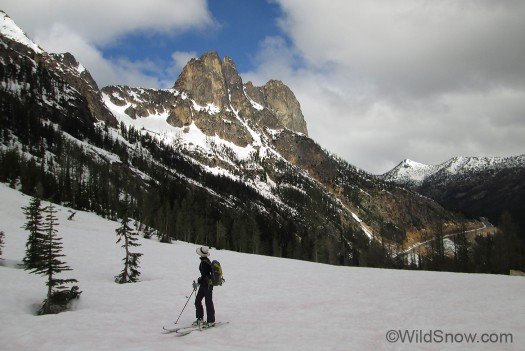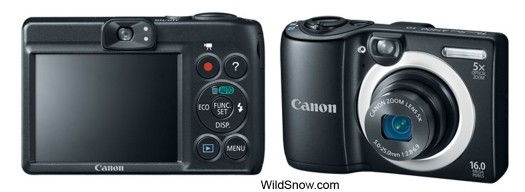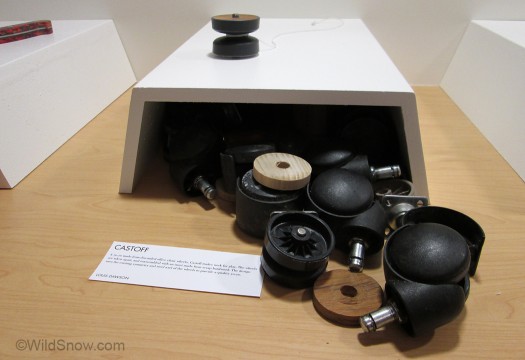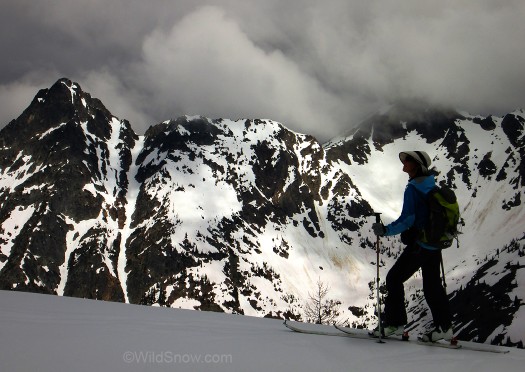
Washington Pass ski tour, shot in snow mode with Canon A1400, ISO100, -2/3 exposure compensation. I did a bit of post processing in Photoshop, as we do with all our photography. Overall, the image is not as crisp as one shot with something like a Canon S100 or G series, but it's totally adequate for web publishing.
I used a Canon S100 camera for backcountry skiing shots this past winter. That high quality yet pocket-sized shooter burns images using the same sensor as the famed G series Canons, only in a much smaller package. I refuse to use anything larger, considering what they fit in such a small package. My S has caught a bunch of excellent shots, with one glaring exception: My percentage of good skiing action photos has fallen like leaves off an aspen tree in October. Why? No viewfinder. Instead, I’m holding the camera up like some kind of pagan offering to the sky gods, trying to see anything! in the viewfinder that’ll give me a clue as to how the ski shot is composed. Usually a grand fail.

Canon A1400, not the solid and feature rich camera the earlier A series cams were, but it has a viewfinder and a bit of control.
So, I’m always looking to try pocket digicams that have an optical viewfinder. Latest I’m playing with is the Canon A1400 (nearly the same camera as the A1300). The “A” in the name means they run on AA batteries. They’re small inexpensive cameras that demand very little power, so you pop two AA lithium cells in there and enjoy amazing battery life, not to mention the simplicity of just using AA cells while traveling or doing multi-day backcountry trips.
We’ve been fans of the A series cameras since the A620 and smaller A720 (among others) gave us amazing tools for backcountry photography. Since then Canon has crippled the A series, probably because if they’d kept things like a manual mode and AV/TV modes they would have cut sales of higher end cameras. That attempt at consumer manipulation was of course a grand failure, as sales of all stand-alone cameras are going down with a giant sucking sound as smartphone cams take over for still and video imaging.
(You can still get used A720 units on Amazon for around $80, and they are still a viable option if you want full manual control of a small, AA battery throw-away camera with viewfinder, albeit without HD video.)
Thus, it’s been a dirge-worthy disappointment that Canon did not morph the A720 form and features by simply adding a better lens and a sensor with more pixels. Instead, we get the 1400/1300. Any good?
Yes, 1400 has double the image pixels at 16 mp instead of the 720’s 8, but the 720 made photos that were perfectly adequate for a decent sized print. You could set it on manual exposure with a high shutter speed, set the focus to infinity, and peer through an optical viewfinder for amazingly good ski shots.
Indeed, if you can find an A720 and don’t feel the need for more than 8 megapixels or HD vid, for snow alpinists the A720 could be the best affordable pocket camera ever made. Heck, it even has a 6x zoom while the 1300/1400 only has a 5x!
Well, no A720’s lying around here any more, so I picked up an A1400. First thing you notice about this little goofball camera is its diminutive size. Fits in the palm of a small hand, and only weighs 174 grams.
How about shooting? I’m still figuring out good settings for action shots, but the optical viewfinder has already upped my percentages across the board.
On the other hand, A1400 doesn’t have many custom settings and that gets in the way of my creativity. So the jury is definitely out on this one.
No manual mode and exposure compensation only goes to plus or minus 2. So there will be some situations where you can’t get the exposure you want. You can compensate for that somewhat with the trick of pointing the camera at something brighter or darker in the image to throw the exposure over, then holding the capture button half way down to lock exposure. Problem is, when you do that you will be adjusting focus as well — that is unless you use a very convenient setting that locks the camera on infinity — nice for basic action ski photography if you’re careful with how far you are from the subject.
Scene mode for “Snow” is included, and results in shots with nice white snow, instead of bluish. But “Snow” mode is crippled for action shots since when you’re in a “Scene” mode you can’t set the ISO to a higher number to force a higher shutter speed. Remember, no TV or AV modes are present, so you can’t fix shutter speed or aperture.

A1400 indoor shot, handheld, no flash, very little post-processing. ISO 200, 60th of second at F 2.8. A yo-yo made out of recycled office chair wheels, in case you are wondering.
P mode (also known as “programable” or “creative”) allows more options and is probably where you’ll want to stay for most shooting with this camera, along with adjusting tones and color balance in your photography software. In P mode you can set a sensitive ISO such as 400 to force a higher shutter speed (experiment), and you’ve got the infinity focus lock. A few white balance settings are available, including custom, so you could do a custom one for the snow while you’re shooting and eliminate some of the post-processing.
A fast continuous shooting rate is one of the big helpers for ski action shots. Sadly, don’t look to this camera for that. It shoots just over 1 shot a second, and is no improvement over the earlier A series Canon cameras. I do get ski shots with 1-per-second shooting, but sometimes find it’s better to wait for that decisive moment and click the shutter to get the money shot.
All settings on the A1400 are done via a tiny button on the back of the camera to the right of the LCD (see image of camera above). While it is a blessing that this control is not the nearly impossible to use fingernail dial of some Canon cams, it’s still a joke to operate with gloves — so be ready with a strategy for bare handed settings. Fortunately, the camera saves many of your settings between on-off cycles, but not all of them. Note that all settings are done via menus in the LCD, so working in a bright sunlit snow environment will require shading the LCD while you fiddle around. Thus, working the settings of this camera requires one to practice diligently so the work can be done with poor visual feedback. Perhaps that’s the advantage of the A1400’s much less complex menus and lack of features.
All that said, the famed CHDK (Canon Hack Development Kit) is available for the earlier A1300 model of this camera, and will probably be available soon for the A1400 . We’ll be testing the CHDK option package, and I’m fairly certain CHDK will enable the A1300/A1400 for a “manual” mode that allows forcing of shutter speed and aperture, as well as capturing images in RAW format. A live histogram on the LCD will help with setting exposures without doing test shots. Operating CHDK on this camera will require sequences of button pushing that’ll be impossible with gloves, so would-be hackers should keep that in mind.

This photo published for yesterday's blog post was taken with A1400. I zoomed it a bit to compress the mountains with the person, and darkened the exposure. Focus was on infinity. ISO 100, 200th of a second at F16.
I should mention more about the A1400 video mode. In a word, lame. So don’t buy this camera for doing much in the way of shooting video. Yes, it does HD, but you can’t zoom while shooting. In fact, you can’t tweak any settings while shooting vid, and the only pre-shot settings are to set video size to HD or 640. (Again, CHDK may enable things like optical zoom while shooting vid, but we don’t know for sure before testing.)
Other loser features of this camera: “Live” mode, which for the life of me I can’t figure is different enough from “P” mode to make it worth the brain cells to learn about. Likewise, a whole complete button is devoted to a “?” symbol that brings up help screens with information so brief and unhelpful you’d think Bill Gates was involved.
Lastly, while the optical viewfinder of the A1400 does function, at certain zoom levels it is grossly inaccurate in terms of the image it frames as compared to what the camera shoots. As far as I can tell, this always results in a looser image than you expect, so you’re not going to lose the edges of an important shot. Yet the poor matching does result in wasted pixels. At 16MP you’ve got a few extra pixels to play with, but it’s too bad the viewfinder isn’t more accurate.
I’ll amend this review or write another one once the A1400 has seen significant use. For now, I’d say it’s worth considering if you want an ultralight camera with viewfinder that eliminates rechargeable battery hassles. As with any camera used for outdoor snowscape imaging, be ready to spend time learning all the settings, and practice using test shots and the histogram to check exposures.
Shop for Canon PowerShot S100 (no viewfinder)
Shop for Canon PowerShot A1400
Canon G Series cameras have the good sensor, opical viewfinder, and full controls that enable shooting action sports with much more ease than forcing a lower end camera. They are bulky and heavy, hence our constant experimenting with “throw away” digicams.
WildSnow.com publisher emeritus and founder Lou (Louis Dawson) has a 50+ years career in climbing, backcountry skiing and ski mountaineering. He was the first person in history to ski down all 54 Colorado 14,000-foot peaks, has authored numerous books about about backcountry skiing, and has skied from the summit of Denali in Alaska, North America’s highest mountain.
